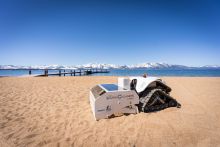
Have you ever wondered how our beaches stay so clean, especially during the busy summer months?
Meet ECO-CLEAN Solutions, a cutting-edge environmental clean-up company dedicated to preserving our lakeshores utilizing low-impact and innovative technology. They understand that the solution to preserving our alpine paradise and inspiring long-term change takes more than passion, it takes creativity and innovation.
Lake Tahoe sees approximately 15 million visitors annually, which results in an increase in waste on the shorelines and fragile ecosystems. While volunteer beach cleanups have helped remove large amounts of waste, ECO-CLEAN Solutions’ introduction of BEBOT, a solar and battery-powered beach-cleaning robot, has maximized these efforts, resulting in clearing more than 45,000 pieces of litter (and growing with each local cleanup effort). On top of litter removal, BEBOT has helped raise community awareness and action to preserve and protect our beloved beaches.
Alongside BEBOT are PixieDrone, a water-skimming waste removal robot, and Collec’Thor, a stationary aquatic waste collector. This powerful trio works in tandem to tackle Tahoe’s litter sustainably and efficiently.
ECO-CLEAN Solutions’ success has not only made a huge local impact, but also inspired new ways of tackling litter and environmental challenges. As the company grows, one of its long-term goals is to continue its efforts and expand along the California coastline, especially on beaches affected by heavy tourist traffic.
Sustainability and conservation are core values of many locals in the Tahoe region, and the advancements in technology have helped pave the way for positive change on personal and community levels ECO-CLEAN Solutions shows us in real-time the impact we have on our environment, and how we can all come together to make the vision of preserving Tahoe’s beauty a reality.
I had the opportunity to interview Katy Jo Caringer, director of marketing and communications for ECO-CLEAN Solutions, and learn more about the company, its mission and the outstanding impact it has made on our shorelines and waterways. And, ECO-CLEAN Solutions is just getting started! This year, they are planning more beach cleanups, community events and data collection to further their efforts in conservation, outreach and education.
Continue reading below for Katy Jo’s responses and to learn more about how you can get involved.
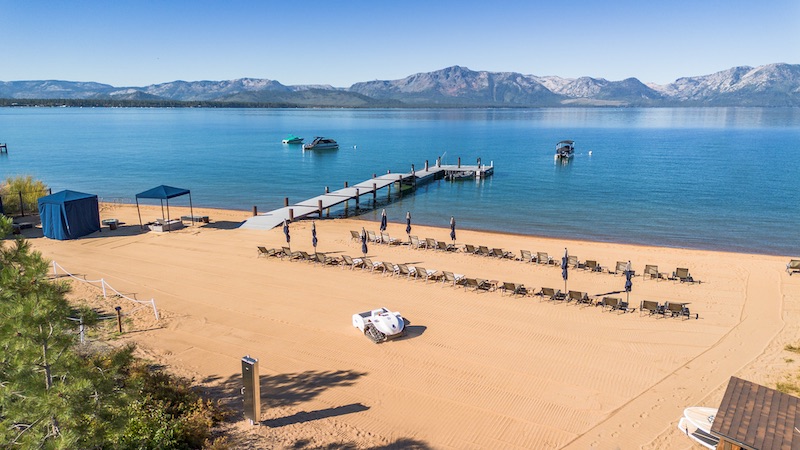
BEBOT cleans up Tahoe Beach Club and restores the shoreline to pristine conditions.
Q: Can you tell us a bit about yourself, ECO-CLEAN Solutions and how the company grew from a local sustainability initiative into its larger mission utilizing innovative, low-impact technology and data and setting the standards for eco-friendly technology for beach restoration?
A: I first got involved as a volunteer in early 2022 after moving from Boulder, Colorado, to Lake Tahoe to reconnect with nature and be closer to family. As a photographer and drone pilot, Tahoe is my dream come true, and as a bonus, I got to meet BEBOT, Tahoe’s very own beach-cleaning robot.
ECO-CLEAN Solutions was born during the wild COVID tourism surge, when Tahoe’s beaches were getting loved to death. The environmental toll became impossible to ignore. Our co-founder, JB Harris, was working at a local tiki bar on the beach and found himself spending more time picking up trash than hanging out with his young son. He knew there had to be a better way.
JB teamed up with his longtime friend JT Chevallier to bring the first solar and battery-powered beach-cleaning robot of its kind to the West Coast. Sourcing the technology from a French company called the Searial Cleaners, we’ve since expanded to three BEBOTs and added two aquatic robots to our fleet.
What started as a grassroots cleanup effort has grown into a full-scale mission – partnering with agencies, resorts,+ and environmental groups to help redefine what sustainable tourism looks like in Tahoe.
Today, we’re out cleaning beaches and waterways around the lake with a growing fleet, backed by science, strong partnerships and a whole lot of heart. At the end of the day, we just want to give back to this place that’s given us so much and build a community that cares about the long-term sustainability of Lake Tahoe as much as we do.
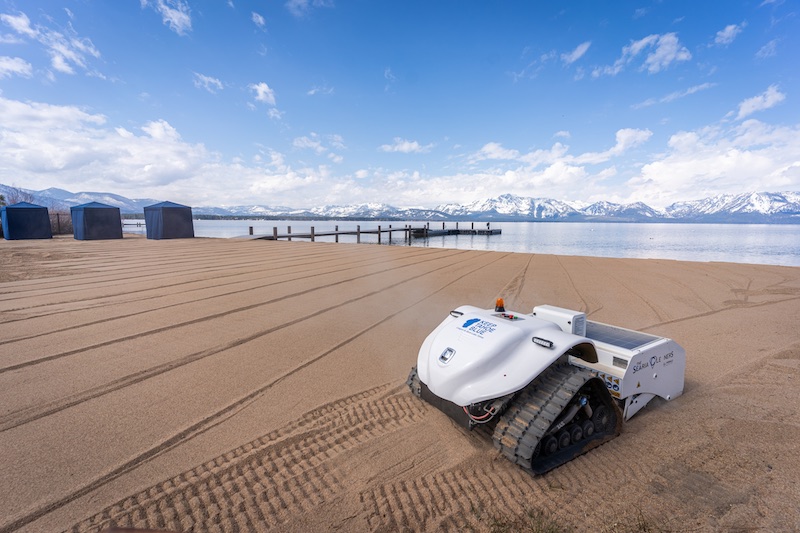
BEBOT at Tahoe Beach Club in 2025, the first private beach in Lake Tahoe to deploy BEBOT.
Q: Can you tell us more about BEBOT and PixieDrone? What does each one do, and what sets them apart from other similar technologies in the field?
A: BEBOT is our solar and battery-powered beach-cleaning robot that sifts 1 to 3 inches into the sand, picking up all debris as small as 1 centimeter, including cigarette butts, bottle caps and food wrappers – debris that often gets buried and overlooked. It’s low-impact, zero-emission and currently the only TRPA-permitted mechanical beach cleaner in Tahoe. Before each deployment, we work with TRPA to survey the beach and protect native species like the Tahoe Yellow Cress.
PixieDrone is our aquatic skimming robot, currently in pilot testing at the Tahoe Keys Marina. It collects floating trash, dock debris like Styrofoam and invasive weed fragments before they can spread. It can also be equipped for water quality monitoring, making it a versatile tool for lake health.
In 2024 we launched another pilot: Collec’Thor, a stationary waste collector that silently attracts and captures floating litter and weed fragments 24/7. Our team is actively tracking the debris it collects to identify pollution hotspots and determine the most effective long-term placement.
Together, BEBOT, PixieDrone and Collec’Thor form a trio of innovative tech tackling Tahoe’s litter from land to water – quietly, efficiently and without emissions.
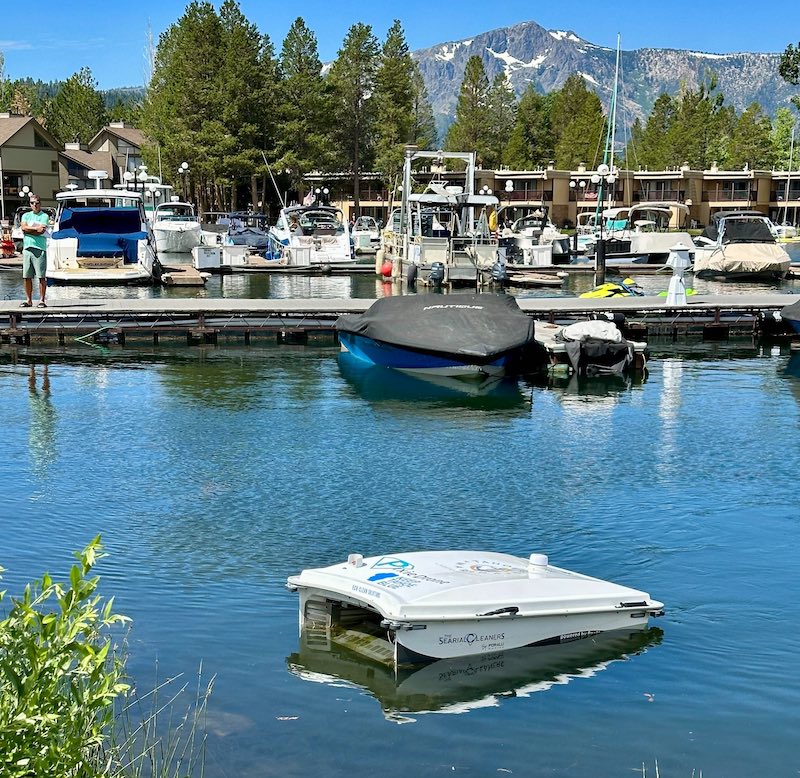
Q: What does a typical "day in the life" in the field of beach cleanup look like?
A: Our crew starts early at our South Lake Tahoe HQ, where we store our growing robot fleet in an airplane hangar (a major upgrade from the garage days). After loading BEBOT into the trailer, we head to the beach and aim to start by sunrise. Cleanups typically run from 6 to 10 a.m. to avoid interrupting beachgoers (and that’s about how long BEBOT’s battery lasts anyway).
Once we arrive, we clear large obstacles and get to work. Debris collected by BEBOT is emptied onto tarps for hand-sorting organic material like pinecones, rocks and sticks that get returned to the beach, while litter is sealed in buckets for data logging. The only thing left behind is a perfectly clean beach, with that “fresh corduroy” look, just like the ski slopes, but in the summer. We also love chatting with curious beachgoers and often let kids take a turn driving BEBOT (it’s always a hit)!
In 2024 we partnered with research students from Desert Research Institute (DRI) to track litter accumulation over time. At select beaches, we clean the same fixed polygon at the beginning and end of summer, logging every item by type and location. That data helps inform smart environmental policies, like the new plastic water bottle ban in South Lake Tahoe.
After the cleanup, BEBOT heads home to recharge for a few hours, then he’s ready to roll again the next day!
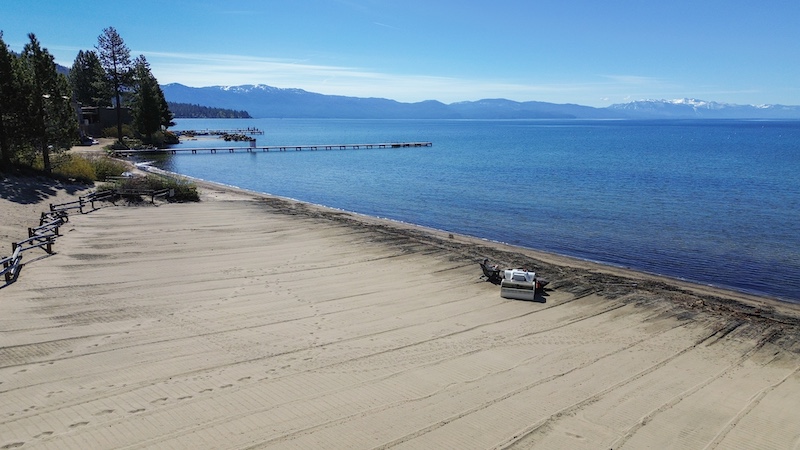
BEBOT completed a beach-cleaning at Moon Dunes beach in North Lake Tahoe, May 2025.
Q: Since launching, how much trash has been removed so far?
In our first year, we collected around 5,000 pieces. That number doubled in 2023, and in 2024 we removed another 30,000 pieces across 21 cleanups on 11 beaches. As we’ve expanded operations and added more robots, our impact has scaled right along with us. We’re off to a great start in 2025.
We recently launched an interactive StoryMap of BEBOT with our partners at Keep Tahoe Blue that shows what beaches we’ve cleaned and what we’ve collected, backed by GPS data and itemized litter logs. (You can check it out here.)
We see BEBOT as the last line of defense before litter becomes microplastic pollution that’s nearly impossible to remove. Every piece counts, and thanks to support from programs like TOT-TBID Dollars at Work, the North Tahoe Community Alliance and longtime partners at Keep Tahoe Blue, we’ve been able to grow this mission and protect more of the shoreline each year.
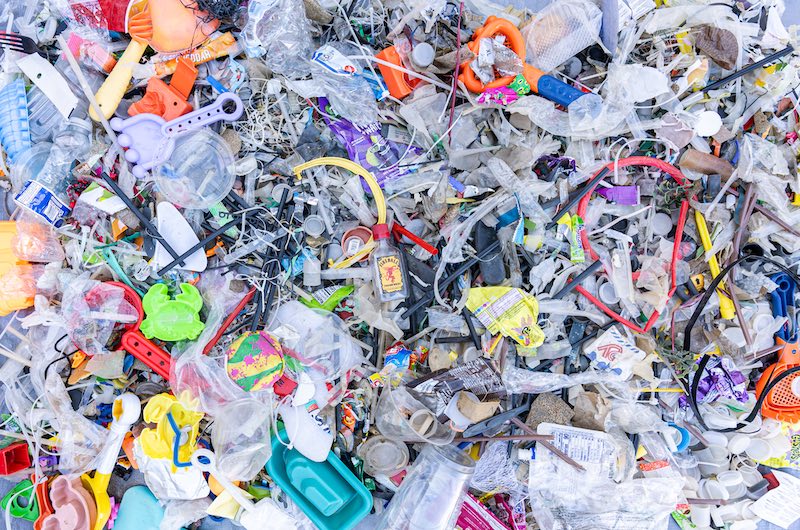
A small sample of the plastic litter collected by BEBOT on Tahoe’s beaches in 2024.
Q: What has been your most rewarding moment or accomplishment so far, and how has that inspired you to build upon your cutting-edge technology and community education and outreach?
A: We were truly honored to receive the Best in Basin Award for Science & Innovation from the Tahoe Regional Planning Agency in 2024 and a Blue Ribbon Award from the Tahoe Chamber this summer. But honestly, the most rewarding part of this journey is seeing people light up when they see our work and BEBOT in action.
We’ve had kids run up and ask if it’s WALL-E. Locals stop to take videos. Visitors ask how they can help. That kind of energy reminds us that what we’re doing really matters, not just for the environment, but for building a community that genuinely wants to protect this place we all love.
Every cleanup reinforces that most people do care, and this is turning into a true grassroots movement. That’s what keeps us going!
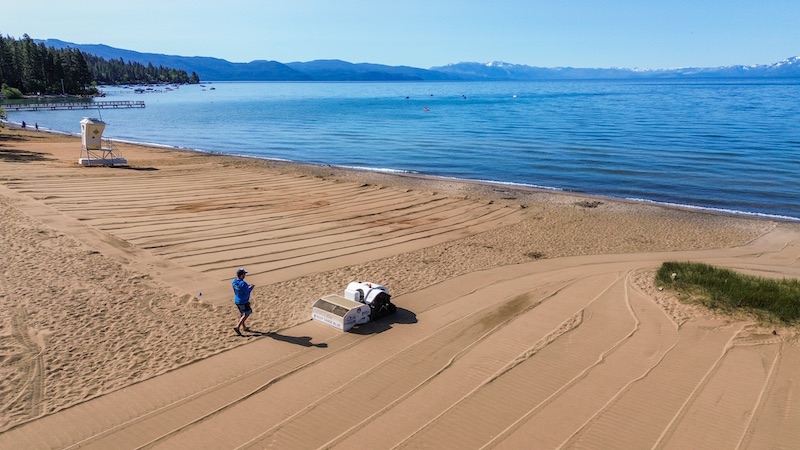
BEBOT completed a full beach cleanup at Kings Beach in North Lake Tahoe in June 2025.
Q: What's next for ECO-CLEAN Solutions?
A: At ECO-CLEAN Solutions, we’re not just cleaning shorelines and waterways – we’re rethinking how we care for the places we love. Our mission is to expand our impact using eco-friendly, low-impact technologies that tackle today’s toughest environmental challenges.
Thanks to tourism-generated funding and incredible community partners, we’ve been able to grow our operations around the Basin, and we’re excited to keep that momentum going into 2026. A long-term goal of ours is to expand down the California coast, where other heavily visited beaches could benefit from innovative tools like BEBOT. We aim to help land managers, marinas and resorts integrate these innovative solutions into their regular shoreline maintenance.
We’ll also continue collecting data to support long-term environmental policy and promote sustainable tourism so these special places can be enjoyed for generations to come.
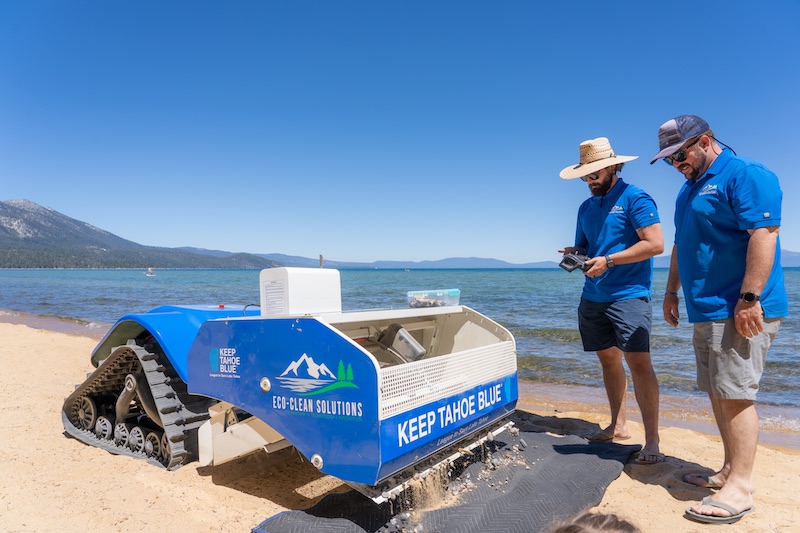
Q: How can the community get involved in beach cleanups and community events?
A: Whether you’ve got five minutes or five hours, there’s always something you can do to help protect Tahoe. Joining a cleanup is a great place to start; there are opportunities all summer, and you can find upcoming dates on our website or through our partners at Keep Tahoe Blue.
You can also join a Tahoe Blue Crew in your neighborhood, which empowers locals to clean up litter right in their communities. I joined one in my area and now bring a 5-gallon bucket on my walks to collect trash, especially after bear break-ins scatter garbage into the forest where it can eventually end up in the lake.
Lake Tahoe sees approximately 15 million visitors annually, more than Yellowstone or Zion, but it doesn’t have the same level of protection. Land managers can’t keep up on their own, so community involvement is essential.
Every single piece of trash picked up helps. It not only keeps the lake clean, but also contributes to valuable litter data that supports policy changes. You can also report litter through the Citizen Science Tahoe app or support the mission by donating to organizations like Keep Tahoe Blue.
At the end of the day, it’s all about taking action, big or small, to protect this place we all love.

Community cleanup group photo at Kings Beach in North Lake Tahoe 2024.
Q: How do you want to inspire locals and visitors to be mindful of their impact on our fragile ecosystem?
A: Research shows that people litter for a few main reasons: They don’t feel connected to a place, they assume someone else will clean up, or they see existing trash and think a little more won’t matter. That’s why we focus so much on visibility, education and inspiring a real sense of connection and stewardship.
We hope that whether you live in Tahoe or are just visiting, you feel how sacred and special this place is – and that you want to help protect it. Our favorite mottos have always been: pack it in, pack it out, and leave no trace. Bring reusables. Secure your trash. Be mindful of the wind (because it will blow your Solo cup right into the lake if you’re not careful)!
Tahoe’s beauty exists because people have fought to protect it, and we’re continuing that fight through innovation, action and community. One piece of trash on the beach is one too many. The more we model responsible recreation, the more it becomes the norm.
We believe protecting Tahoe is a collective effort, and the more people we can inspire to care and act, the better chance we have to #KeepTahoeBlue and beautiful for generations to come.
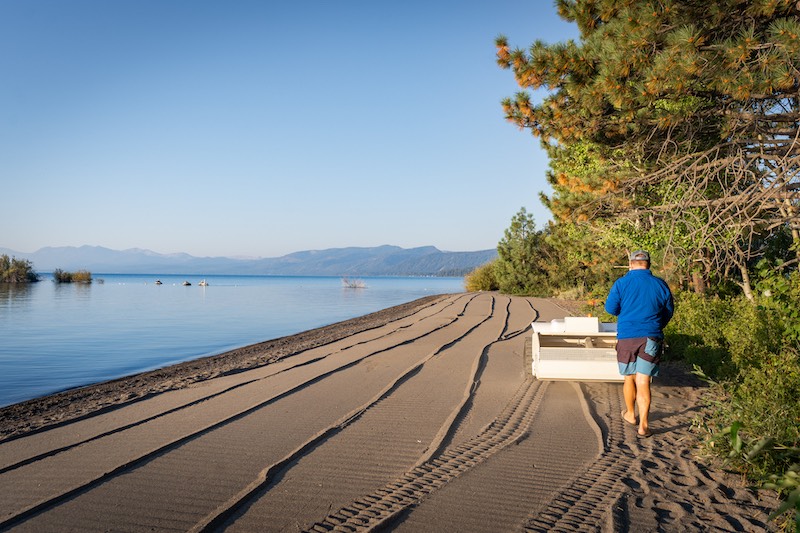
BEBOT in action cleaning the beach at Lake Forest Beach in North Lake, May 2025.
Q: What makes Tahoe so special to you, and what does your ideal future look like in the region?
A: What makes Tahoe so special to me is that it’s not just a place, it’s a feeling and a way of life. It’s those moments when the sun sparkles across its emerald-blue waters or when the alpenglow lingers long after the sun has set. You can’t help but pause in the magic of it all.
Tahoe brings people back to nature and back to what really matters. Our hope is that it stays just as breathtaking for generations to come. Every beach we clean, every data point we log, every conversation we have, it’s all in service of that future.
Someone once asked us, “If Lake Tahoe could speak, what would it say?” And our answer was this: “To those who work tirelessly to protect me – I see you, and I thank you. I have hope for a future where there’s balance between those who love me and what they leave behind.”
That’s the vision we’re working toward every day.
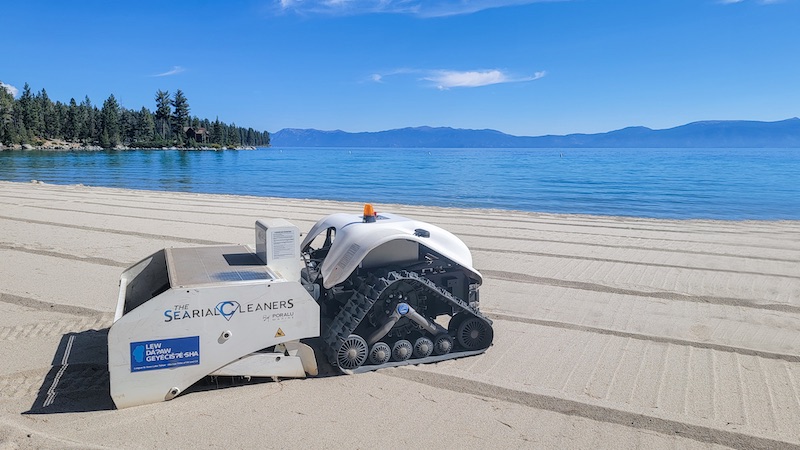
BEBOT post cleanup at Meeks Bay Resort on the West Shore Lake Tahoe, September 2024.


 Kirsten is an outdoor adventure enthusiast, writer and photographer. You can typically find her hiking, paddleboarding, cross-country skiing and checking out new spots to share in the Tahoe Donner region. She has been lucky to call Tahoe her second home since she was a child and aims to inspire people to experience Tahoe and fall in love with the beauty and adventurous spirit of the region through her blogs and content.
Kirsten is an outdoor adventure enthusiast, writer and photographer. You can typically find her hiking, paddleboarding, cross-country skiing and checking out new spots to share in the Tahoe Donner region. She has been lucky to call Tahoe her second home since she was a child and aims to inspire people to experience Tahoe and fall in love with the beauty and adventurous spirit of the region through her blogs and content. 






